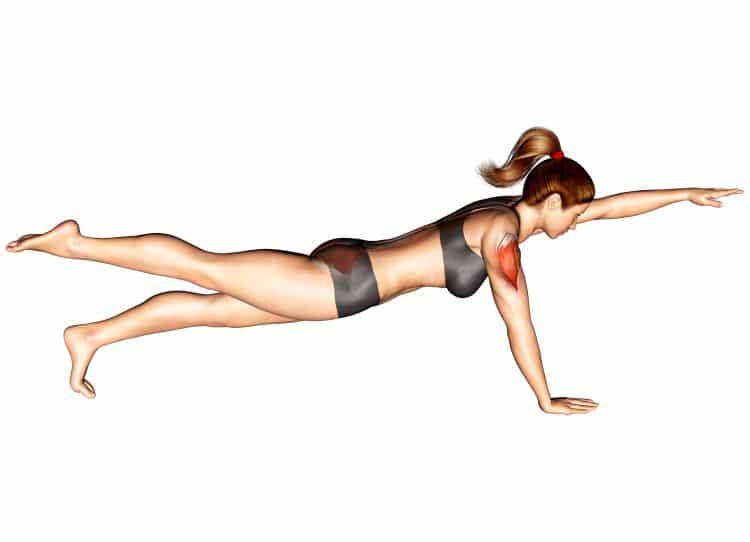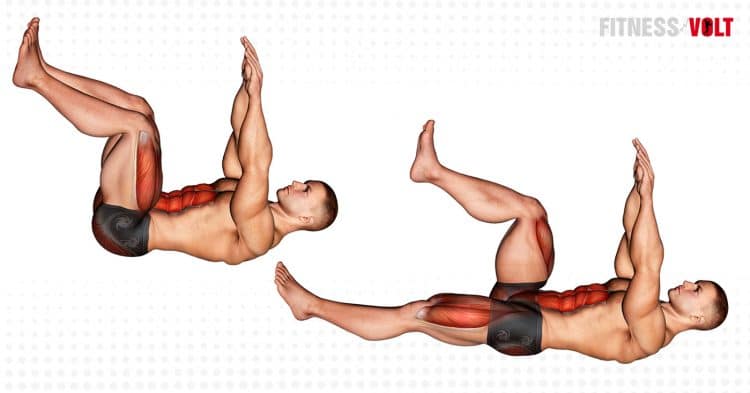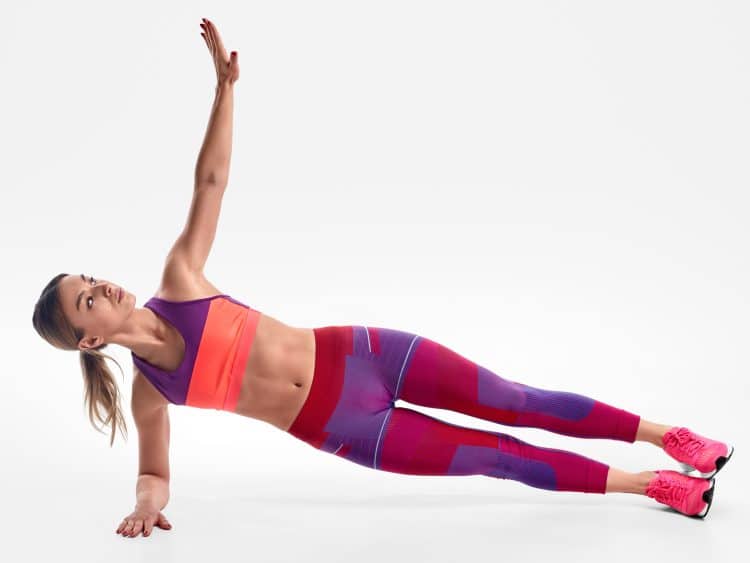When it comes to strength training, most people spend the majority of their workouts focusing on the muscles they can see. They’ll do bench presses for their pecs, curls for their biceps, and squats for their legs. This makes a lot of sense because a large proportion of exercisers are working out to look better.
However, beneath that superficial layer of muscles is another layer that’s every bit as important. The muscles you can’t see also play a role in how you look, perform, and feel.
In this article, we’re going to discuss one of the most important of these invisible muscles – the transverse abdominis, revealing its functions and how best to train it.
10 Best Transverse Abdominis Exercises
A stronger TVA means increased IAP and a more stable lumbar spine. This could a) reduce your risk of back injury, and b) increase your performance in the exercises you’re doing to build strength and muscle mass. The result? Better results from your training.
For example, if, during squats, your TVA bulges outward and you lose IAP. Your lower back may start to round, increasing the stress on your intervertebral disks and spinous ligaments. Also, your hips may rise while the weight remains stationary, reducing exercise performance.
Here are ten of the best exercises for increasing TVA strength.
1. Plank

Planks are a good place to start training your TVA. This classic abs exercise involves a strong bracing element, which means your TVA is especially active. Don’t plank passively and try to see how long you can keep your hips up. Instead, brace your abs as hard as you can, tensing your entire body too.
This is called a hardstyle plank and is much more effective than the lower-intensity version. With hardstyle planks, you should not be able to continue much past 20-30 seconds. If you can, you are not bracing hard enough.
Read more about hardstyle planks, also known as RKC planks, in this detailed guide.
2. Bird dog

Bird dogs don’t look especially hard, but they’re a good exercise for identifying and using your TVA while you move your arms and legs. After all, you need to get used to bracing during all the exercises in your workouts, and not only while stationary, like when you do planks.
How to do it:
- Kneel on all fours with your hips directly over your knees and your shoulders above your hands. Lengthen your neck and look straight down at the floor. Brace your abs.
- Extend your right arm and your left leg, keeping the rest of your body stationary.
- Lower your arm and leg and repeat. Bring your elbow and knee together beneath you if you wish.
- Rest a moment and then swap sides.
- Once mastered, you can do this exercise with your legs straight and knees off the floor, which is called a high bird dog.
3. Dead bug

The dead bug is a more demanding version of the kneeling bird dog. Lying on your back means you’ll have to stabilize your core while lifting and lowering your legs and using your rectus abdominis. This exercise is so-called because you’ll look a little like an insect flailing its legs as it dies!
How to do it:
- Lie on your back with your knees bent. Your upper legs should be vertical, and your lower legs parallel to the floor. Your knees and hips should be at a 90-degree angle.
- Raise your arms, so they are perpendicular to the floor. Flatten your lower back.
- Brace your abs and lower your right arm and left leg down toward the floor. Do not arch your lower back.
- Return to the starting position and repeat with the opposite leg.
- Alternate sides for the duration of your set.
4. Stir the pot
If you can plank like a boss, it’s time to step things up a bit and add some extra movement and instability. With this exercise, you plank as usual but then move your arms which means you’ll have to brace extra hard to prevent unwanted spine extension.
How to do it:
- Place your forearms on a stability ball, and then walk your feet back and into a plank position. Brace your abs.
- When you are ready, rotate your arms in small clockwise and counterclockwise circles. Increase the size of the circles as you get stronger.
- You can also roll the ball forward and backward for variety.
5. Pallof press

Paloff presses were invented by physical therapist John Paloff. Like many TVA exercises, this is an anti-movement exercise, which means you’ll need to brace to stop your spine from flexing, extending, or rotating. There are several Pallof press variations, including:
- Half-kneeling Pallof press
- Split stance Pallof press
- Cable Pallof press
- Overhead Pallof press
- Resistance band Pallof press
Read more about Pallof presses here.
6. Single-arm farmer’s walk
Single-arm farmer’s walks might look more like a forearm exercise than something that’ll strengthen your TVA, but they’re actually a very functional deep abdominal exercise. When doing single-arm farmer’s walks, you’ll have to brace extra hard to avoid leaning sideways.
How to do it:
- Pick up a heavy dumbbell or kettlebell and hold it in one hand, with your arm by your sides. Brace your abs and make sure you keep your torso upright – no leaning toward or away from the weight.
- Walk around your training area for as long as you can. Put the weight down as you feel your grip starting to fail.
- Swap hands and repeat.
Read more about farmer’s walks in this detailed guide.
7. Single-arm waiter’s walk
Bored of farmer’s walks? Try waiter’s walks instead! With this exercise, you hold the weight overhead, which means the load is much less stable. As a result, you’ll need to work even harder to keep your torso upright. As an added benefit, this exercise is good for your shoulder stabilizers – the rotator cuff.
How to do it:
- Clean and press a dumbbell or kettlebell overhead. Pull your shoulder down and back and brace your abs.
- Keeping your arm vertical and locked, walk around your training area for as long as you can.
- Lower the weight, swap sides, and repeat.
- Try supersetting waiter’s walk with farmer’s walk for a very tough and challenging TVA workout.
- Make the waiter’s walk harder by walking around and over obstacles, which will increase the stability demands of this exercise.
8. Rollouts

Rollouts are a sort of moving plank. Most people do this exercise because it’s a great abs strengthener, but it’s also a beneficial TVA exercise. You’ll have to brace hard to stop your lumbar spine from extending as you push your roller away from you. You can do rollouts in several ways, including:
- Kneeling
- Standing
- Abs roller/wheel
- Barbell
- Suspension trainer
- Stability ball
- Landmine
Learn more about this powerful TVA exercise here.
9. Pilates 100
Pilates is a traditional training system invented by Josef Pilates in the 1920s and involves a lot of TVA-specific exercises. The Pilates 100 is effective and convenient move because you don’t need any equipment to do it.
How to do it:
- Lie on your back with your legs straight and arms by your sides. Brace your abs and lift your legs so they’re about 45-degrees to the floor. Lift your arms a few inches off the floor. Flatten your lower back.
- Lower and raise your arms 100 times while continuing to brace the entire time.
- Make this exercise easier by bending your knees.
10. Push-up to side plank

Push-up to side plank exercise hits your TVA from multiple angles. It combines moving your upper body with bracing your core, making it both functional and time-efficient.
How to do it:
- Place your hands on the floor about shoulder-width apart and walk your feet back until your body is straight. Brace your abs.
- Bend your arms and lower your chest to within an inch of the floor.
- Push yourself back up, shift your weight onto one hand, and then turn your shoulders until you are resting on one outstretched arm. Extend your other arm up toward the ceiling to form a T-shape. Pause here for 2-3 seconds.
- Return to the push-up position, do another rep, and then repeat on the opposite side.
- Continue alternating sides for the duration of your set.
Transverse Abdominis
When asked, most people can identify their main midsection muscles. After all, a lot of exercisers are working out specifically to achieve a lean, toned six-pack. Even non-gym-goers are familiar with the term abs and may even know that it’s short for rectus abdominis.

However, below the abs is another set of muscles which are often referred to as the inner unit. The inner unit comprises three lesser-known but no less important muscles:
- Diaphragm – your main breathing muscle and the top of your inner unit
- Pelvic floor – a figure-eight-shaped muscle that supports your pelvic organs
- Multifidus – a muscle located across your lower back
- Transverse abdominus – a deep abdominal muscle that encircles your abdomen like a belt
Of these four muscles, the transverse abdominis, or TVA for short, is arguably the most important because it’s the easiest to control and train.
The TVA encircles your waist like a broad, muscular weightlifting belt or corset. It’s a thin muscle, but it’s also powerful. To feel your TVA working, sit or stand with your thumbs on your waist and your fingers on your abs.
Exhale forcefully, and you’ll feel tension beneath your fingers, and your muscles will contract inward. That’s your TVA in action, working alongside your rectus abdominis to compress your abdominal contents.
The TVA also plays a critical role in stabilizing your spine and preventing unwanted movement during exercises like squats, deadlifts, and overhead presses. In fact, we purposely increase TVA activation to maximize core stability. This is usually called bracing.
To brace, pull up your pelvic floor like you are trying to stop the flow of urine. Next, tense your abs as if you were excepting to get punched in the gut. Finally, inhale without allowing your abs to bow outward. Done correctly, you should feel your entire midsection stiffen.
Bracing increases intra-abdominal pressure or IAP for short. This stabilizes your spine from within, taking pressure off your intervertebral disks (1). If your TVA is weak and bulges outward, you’ll lose IAP, which could reduce your exercise performance and might even result in injury.
Bracing should be an automatic response to any physically demanding activity. However, prolonged sitting and a generally sedentary lifestyle mean that a lot of people have lost the ability to brace subconsciously. That’s why, in almost all of the exercise descriptions on Fitness Volt, you’ll see instructions to “brace your core” or “brace your abs.”
A stronger TVA means more intra-abdominal pressure and a more stable, less compressed spine. Wearing a weightlifting belt can help increase IAP, but unless you plan on wearing one 24/7, it’s also worth working on your TVA. That way, you’ll be able to generate plenty of IAP both in and out of the gym.
Interestingly, wearing a belt gives you something to press your abs against, increasing IAP (2). However, even wearing a belt, it’s still your TVA that is responsible for increasing intra-abdominal pressure and supporting your spine.
Read more about using a weightlifting belt here.
TVA is involved in almost every exercise you perform, including abs exercises. But there are several exercises you can do to target this muscle more directly, increasing TVA strength.
More Abs Exercises:
- The 10 Most Awesome Upper Abs Exercises
- 15 Best Cable Exercises for Abs
- 10 Barbell Exercises For Abs
- Do Squats Work Your Abs?
- 7 Ways to Do Rollouts When You Don’t Have an Abs Wheel
- Best Abs Exercises to Build Core Strength for CrossFit
- Planking It! Five Minute Plank Workout for Shredded Abs
Transverse Abdominis Exercises – Wrapping Up
Just because you can’t see your transverse abdominis doesn’t mean it’s not a crucial muscle. It supports your spine when you are doing many of the exercises in your workout and, if it’s weak, it could undermine your performance and affect your progress. It could even increase your risk of back injury.
As well as engaging your core and bracing during your workouts, you may benefit from some more direct TVA training. You don’t have to go all TVA, all the time. But, it’s definitely worth incorporating a couple of TVA exercises into your regular abs workout. The good news is that most of them also work your rectus abdominis and obliques, so you’ll get plenty of bang for your training buck.
References:
1– PubMed: Role of Intra-Abdominal Pressure in The Unloading and Stabilization of The Human Spine During Static Lifting Tasks https://www.ncbi.nlm.nih.gov/pmc/articles/PMC3233951/
2– PubMed: Effects of A Belt On Intra-Abdominal Pressure During Weightlifting https://pubmed.ncbi.nlm.nih.gov/2709981/


